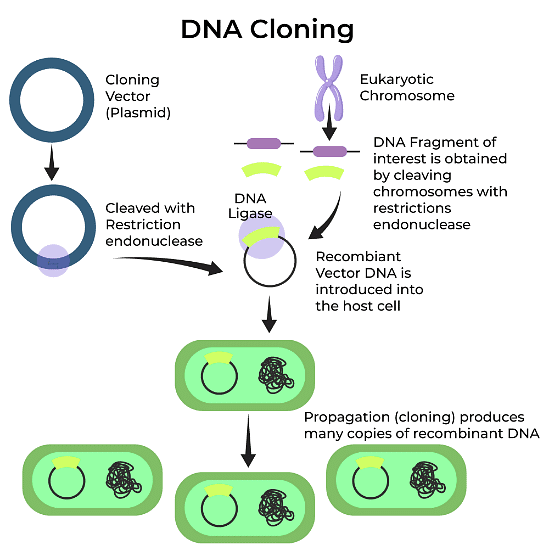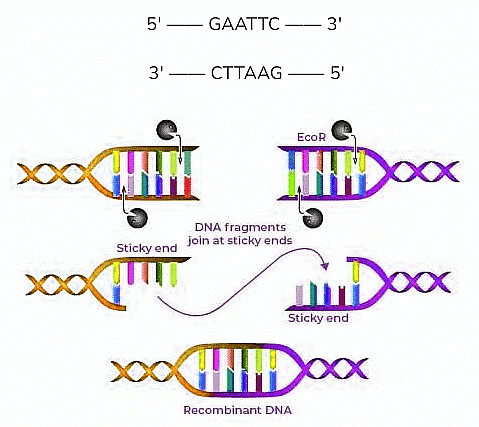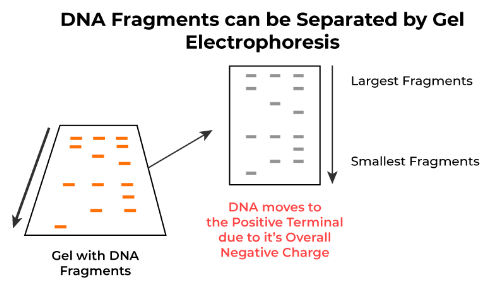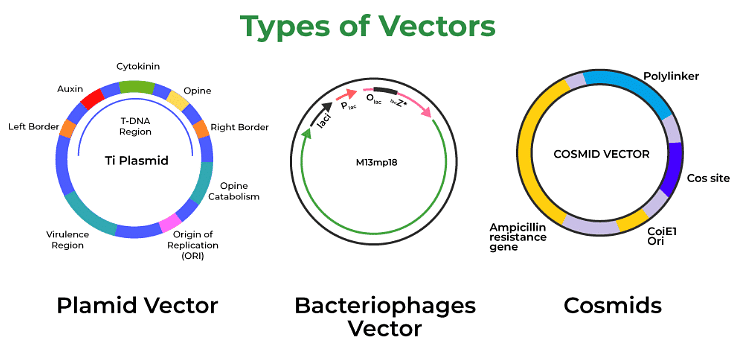Biotechnology: Principles and Processes Chapter Notes | Biology Class 12 - NEET PDF Download
Biotechnology
Biotechnology, stemming from the Greek words "bios" (life), "techno" (technology), and "logos" (language or proof), harnesses living organisms for various applications like food production, medicine, and environmental sustainability. By merging biology and technology, biotechnology offers solutions across multiple industries.
Its benefits span medicine, environmental conservation, marine sciences, and industrial processes, empowering farmers with cost-effective tools for enhanced crop management. For instance, genetically modified crops resistant to specific herbicides streamline weed control.
Legend has it that the term "biotechnology," or "biotech," was coined in 1919 by Hungarian engineer Karl Erecki. Today, it's a burgeoning field with opportunities in pharmaceuticals, agriculture, healthcare, and genetic engineering.
Genetic engineering manipulates an organism's genetic makeup by inserting desired genes using cloning vectors, resulting in observable changes in phenotype.
Bioprocess engineering accelerates large-scale production of various products like enzymes, antibodies, and vaccines by cultivating microorganisms under controlled, sterile conditions.
Bioinformatics involves storing, preserving, and retrieving biological data such as genome and protein sequences for diverse applications.
Principles of Biotechnology
In the field of bioinformatics, biological data, including genome and protein sequences, are stored, preserved, and retrieved for various applications.
Fundamental Techniques in Modern Biotechnology:
- Genetic Engineering: Genetic engineering involves altering the genetic material (DNA and RNA) chemically, inserting it into host organisms, and thereby changing the characteristics of the host organism.
- Preservation of a sterile environment during chemical engineering processes is crucial for enabling the large-scale cultivation of only suitable microorganisms or eukaryotic cells. This facilitates the production of biotechnological goods such as antibiotics, vaccines, and enzymes.
Main Methods in Genetic Engineering:
- The DNA fragment of the donor organism is extracted.
- This fragment is inserted into the DNA of the vector.
- Subsequently, it is transferred to the appropriate host.
- The host organism's recombinant DNA is cloned.
Recombinant DNA
Genetic engineering methods like recombinant DNA production, gene cloning, and gene transfer allow us to extract and introduce specific genes without introducing undesired genes into the target organism.
DNA Cloning

DNA cloning involves creating multiple identical copies of a DNA segment. This process requires the use of cloning vectors with specific attributes:
- Compact size yet capable of carrying a large DNA fragment.
- Contains a replication origin for spontaneous replication in the host organism.
- Presence of a restriction site for manipulation.
- Incorporates a selectable marker for identifying recombinant organisms.
- Offers multiple cloning sites for insertion of DNA fragments.
Origin of Replication
- The origin of replication, found in the chromosome, kickstarts the replication process within DNA.
- For any foreign DNA to replicate within an organism, it must be part of a chromosome with a specific sequence known as the 'origin of replication'.
- DNA replication origins are regions where DNA multiplication commences, comprising elements such as the pre-replication complex region and proteins for binding and recognition.
Plasmids
- Plasmids are small, circular DNA structures that can replicate independently, not relying on the host organism's chromosomal DNA for reproduction.
- These extrachromosomal DNA molecules play a crucial role in genetic engineering processes like gene cloning and gene therapy.
- Found in bacteria and certain eukaryotic organisms, plasmids vary in size from 1 to 200 kilobases (kb).
- Some plasmids carry genes encoding enzymes capable of breaking down antibiotics or heavy metals, offering survival advantages to the host organism.
- Plasmids are categorized into five main types:
- Fertility F-plasmids
- Resistance plasmids
- Virulence plasmids
- Degradation plasmids
- Col plasmids
Recombinant DNA Technology
- Recombinant DNA technology alters the characteristics of an organism by introducing a genetically modified vector into its genome.
- This process involves inserting a foreign segment of DNA, containing the desired genes, into the organism's genetic material.
- The introduced gene is known as the recombinant gene, and the entire procedure is termed recombinant DNA technology.
Key Tools of Recombinant DNA Technology
- Restriction Enzymes: These enzymes cut DNA at specific sequences, allowing the isolation of gene segments for manipulation.
- Vector: A vector is a carrier used to transfer the foreign DNA into the host organism. Common vectors include plasmids and viruses.
- Ligase Enzyme: This enzyme is used to join the foreign DNA with the vector DNA, creating recombinant DNA molecules.
- Host Organism: The organism into which the recombinant DNA is inserted to produce the desired protein or trait.
Tools of Recombinant DNA Technology
- Various tools are crucial for genetic engineering to be successful, including restriction enzymes, polymerase enzymes, ligases, vectors, and host organisms.
Restriction Enzymes
- Restriction enzymes play a significant role in determining where a gene is inserted into a vector genome.
- The first isolated restriction enzyme, E-coli, dates back to 1963 and was derived from bacteriophage development in the lab.
- Hind II, isolated in 1970 by Hemeltan Smith and colleagues, cleaved DNA at specific sites, recognizing six double standard DNA sequences.
- There are around 900 known restriction enzymes, each recognizing distinct recognition sequences and originating from over 230 bacterial strains.
- Restriction enzymes belong to the nuclease class, which degrades DNA molecules by breaking phosphodiester bonds.
- Nucleases consist of exonucleases and endonucleases, with the latter making cuts at specific locations within DNA.
- Restriction endonucleases cut DNA at specified sites, following sequence-specific and usually palindromic sequences.
Restriction Enzymes Overview
- Nucleases and Restriction Enzymes: Nucleases belong to a category of enzymes that break down DNA molecules by cleaving the phosphodiester bond between nucleotides. Within nucleases, there are two main types: exonucleases, which remove nucleotides sequentially from the DNA ends, and endonucleases, which cut at specific positions within the DNA.
- Restriction Endonucleases: These enzymes cut DNA at precise locations. They are sequence-specific, recognizing particular palindrome sequences within the DNA molecule.
- Function of E-coli Exonucleases: For instance, in E. coli, exonucleases degrade one end of double-stranded DNA, resulting in single-stranded DNA. The sequences are read in the 5' to 3' direction on both DNA strands.
- Palindromic Sequences: Palindromic sequences are sequences that read the same forwards and backward. For instance, a palindromic sequence might look like this: 5' - GAATTC - 3' on one strand and 3' - CTTAAG - 5' on the complementary strand.
Illustrative Example
Visual Representation: The image below illustrates a visual representation of restriction enzymes in action:
Separation and isolation of DNA fragments

- The process of separating and isolating DNA fragments involves cutting DNA using restriction endonucleases, resulting in DNA fragments.
- These fragments are then separated using a method known as gel electrophoresis.
- A thin layer of polyacrylamide gel is used, with DNA placed onto it. Due to their negative charge, DNA fragments move towards the anode during electrophoresis.
- Agarose, derived from certain seaweeds, is a key component of the gel that aids in the separation of DNA fragments based on size.
- Separation occurs due to the sieving effect provided by the agarose gel.
- After staining the DNA with ethidium bromide dye and exposing it to UV radiation, bright orange DNA bands become visible on the gel.
- The separated DNA bands are then cut out from the agarose gel in a process known as elution.
- The purified DNA fragments are used to create recombinant DNA when combined with cloning vectors.
Vectors
- Vectors play a crucial role in recombinant DNA technology by transporting and integrating the desired gene. They act as carriers that facilitate the transfer of the gene into the host organism.
- Two primary types of vectors utilized in recombinant DNA technology are bacteriophages and plasmids.

Cloning Vector
A cloning vector is a DNA molecule utilized to transport foreign DNA into a host cell. It possesses the ability to self-replicate and integrate into the host cell, contributing significantly to the analysis of DNA's molecular structure.
These vectors can be derived from a bacterium's plasmid, a higher organism's cell, or DNA from a virus. The target DNA is inserted into specific sites on the vector and connected using DNA ligase. Subsequently, the host cell is modified to accept the vector, enabling replication.
A cloning vector is a DNA molecule that, upon insertion of foreign DNA, can independently replicate to produce multiple clones of recombinant DNA. Examples of cloning vectors include plasmids and phages.
Characteristics of Cloning Vectors
Cloning vectors require certain essential characteristics to function effectively. These include a suitable cloning site and selectable markers. Some additional features may be present, but their utility is limited. Cloning typically occurs in E. coli, so cloning vectors often contain systems that facilitate maintenance and operation in E. coli. In some cases, they may possess attributes that enable persistence in organisms other than E. coli.
- Origin of Replication: The specific DNA sequence acting as the origin of the replication process, known as ORI, initiates replication of foreign DNA alongside the host cell.
- Selectable marker gene: Cloning vectors must include a selectable marker gene to facilitate the identification and separation of host cells containing recombinant DNA from those that do not.
- Presence of restriction sites: Cloning vectors should feature restriction sites that allow for the cleavage of specific sequences by restriction endonucleases.
Other considerations for cloning vectors include:
- Optimal size to avoid interference with replication and integration processes
- Multiple cloning sites for flexibility
- Utilization of the same restriction enzymes for vector and donor DNA digestion
- Expression vectors may contain components for target gene expression
Key Criteria for Cloning Vectors
- Size Consideration:
Cloning vectors should maintain a manageable size, not overly large.
- Integration Compatibility:
Donor DNA integration must not disrupt the cloning vector's replication dynamics.
- Multiple Cloning Sites:
Cloning vectors should offer numerous sites for gene insertion.
- Uniform Digestion and Recombination:
Both the vector and the sample DNA should be digested using the same restriction enzymes before recombining. This process enables growth within a host. Selectable markers within the vector aid in identifying the inserted recombinant.
- Expression Vector Flexibility:
A cloning vector may or may not possess components conducive to gene expression, although many do serve as expression vectors.
Types of Cloning Vectors
- Plasmid Cloning Vectors:
Plasmids are widely used bacterial cloning vectors, featuring a polylinker with multiple common restriction sites for DNA fragment insertion. These vectors are typically around 4361 bp in size, with a cloning range of 0.1 to 10 kb. They commonly confer ampicillin and tetracycline resistance, aiding selection. An example is PBR322.
- Bacterial Artificial Chromosome (BAC):
BACs, at 11827 bp in size, are utilized to clone DNA sequences in bacterial cells like E. coli. They find extensive use in DNA sequencing, offering a cloning range of 35-300 kb. Marker genes like chloramphenicol and lactose metabolizing genes aid in identification. An instance is pUvBBAC.
- Yeast Artificial Chromosome (YAC):
YACs, artificially designed DNA molecules, serve as cloning vectors in yeast cells. With a length of 11400 bp and a cloning vector size ranging from 100-1000 kb, YACs are pivotal in genome mapping and sequencing, utilizing yeast-centric markers.
- Bacteriophage Vectors:
Bacteriophage lambda vectors, surpassing plasmids in size at 48502 bp, serve as expression vectors in cloning procedures. They can accommodate approximately 4-5 kbp of donor DNA for recombination, showcasing higher capacity than plasmids. Lambda genome is a prime example.
- Cosmid Vectors:
Cosmids, with a size of 7900 bp and a cloning range of 30-50 kb, blend characteristics of phage and plasmid vectors. An illustration is super COS1.
- Human Artificial Chromosome:
These specialized artificial chromosomes are instrumental in transferring human genes, boasting an expansive DNA-carrying capacity without restrictions on cloning.
 |
Download the notes
Chapter Notes- Biotechnology: Principles and Processes
|
Download as PDF |
Process of Gene Cloning
- Step 1: Extraction of Donor DNA Gene - The donor DNA gene is isolated using either the restriction endonuclease enzyme or reverse transcriptase enzyme.
- Step 2: Selection of a Suitable Vector - Since an isolated gene cannot replicate independently, a specific vector must be chosen to support the replication process. Cloning vectors possess particular characteristics.
- Step 3: Integration of the Donor Gene into the Vector - The vector is cut using the same restriction enzyme as the DNA to separate the gene. Through the action of DNA ligase, the vector and donor gene are combined to form a recombinant vector.
- Step 4: Introduction of the Recombinant Vector to a Host Cell - The resulting recombinant vector is introduced into a host cell. Some cells naturally undergo transformation, such as Bacillus, while others require artificial methods for transformation.
- Step 5: Separation of the Recombinant Cell - The host cell is cultured to enable growth, containing both recombinant and non-recombinant cell types. Separation based on the marker gene used is essential.
Process of Recombinant DNA Technology
- Recombinant DNA technology involves selecting the appropriate gene for insertion into the host organism.
- Next, a suitable vector is chosen to integrate the gene, forming recombinant DNA.
- The recombinant DNA is then introduced into the host organism.
- Finally, the modified DNA must be maintained within the host and passed on to future generations.
Isolation of DNA
- Isolating DNA is challenging due to its presence within the nucleus of cells.
- Cells from plants or animals undergo enzymatic treatment to extract pure DNA.
- Enzymes such as cellulose, lysozyme, and chitinase are used for isolating DNA from different types of cells.
Fragmentation of DNA
- Isolated DNA is fragmented using restriction endonucleases, which cut the DNA into smaller pieces.
- These enzymes help in identifying the integration site of the desired gene into the vector genome.
- Restriction endonucleases recognize specific sequences and cut the DNA at particular points.
- By cutting at specific sites, these enzymes create sticky ends that facilitate the joining of genes and vectors by ligases.
Amplification of Gene of Interest
- PCR (Polymerase Chain Reaction) is a method used to amplify a specific gene by cutting it out with restriction enzymes.
- This technique allows for the production of multiple copies of the desired gene.
- The PCR process involves three main phases: denaturation, annealing, and extension.
Insertion of Recombinant DNA into the Host
- The host organism plays a crucial role in recombinant DNA technology, serving as the recipient for the engineered vector containing the desired DNA.
- Various methods are employed to introduce the recombinant DNA into the host, such as:
- Microinjection
- Heat and cool techniques
- Gene cannon or biolistics
Obtaining the Foreign Gene Product
- In genetic engineering processes, the target gene is carefully chosen before selecting an appropriate vector for gene integration. Subsequently, the gene of interest is combined with the vector to create recombinant DNA.
- Following the integration of the foreign DNA, the host organism undergoes replication and starts synthesizing the desired protein. It is crucial for the recombinant DNA to be retained within the host and passed on to future generations.
- For the production of the desired protein, the gene responsible for encoding it must be activated. This activation usually requires specific and optimized environmental conditions to be in place.
- Production of the target protein needs to occur on a large scale to meet the intended objectives of the genetic engineering process.
- Recombinant cells can be cultured extensively through a continuous culture system, where cells are grown in a large vessel. The growth medium is regularly replenished to maintain optimal conditions, facilitating the production of significant quantities of the desired protein.
- To achieve high-volume production of the protein, bioreactors can be employed as specialized vessels that support the growth of cells and the production of proteins through controlled environmental conditions.
Bioreactor
- A bioreactor facilitates the efficient production of a large quantity of cultures. It serves as a sizable vessel where various types of cells, such as human, plant, or animal cells, can be nurtured to generate new biological substances.
- Bioreactors create and maintain suitable conditions like temperature, pH levels, substrate availability, and oxygen supply necessary for the cultivation of cells to produce the desired biological products.
- There are two primary types of bioreactors used for this purpose: simple stirred-tank bioreactors and sparged stirred-tank bioreactors.
Downstream Processing
- Downstream processing represents a step-by-step phase where the final products are extracted, purified, and preserved before they are ready for distribution in the market.
- During downstream processing, the final product is enhanced with additional components such as preservatives, pigments, and other additives to improve its stability and market appeal.
|
78 videos|280 docs|174 tests
|
FAQs on Biotechnology: Principles and Processes Chapter Notes - Biology Class 12 - NEET
| 1. What are the principles of biotechnology? |  |
| 2. What is recombinant DNA technology? |  |
| 3. What are restriction enzymes and their role in biotechnology? |  |
| 4. What are cloning vectors and how are they used in biotechnology? |  |
| 5. What is the importance of bioreactors in biotechnology processes? |  |





























